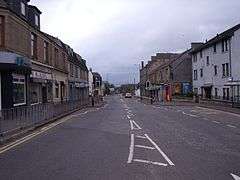Laurieston, Falkirk
Laurieston is a village in the Falkirk council area in Central Scotland. It is 1.5 miles (2.4 km) east Falkirk, 1.6 miles (2.6 km) south-west of Grangemouth and 1.6 miles (2.6 km) west of Polmont.
Laurieston
| |
|---|---|
 Looking west towards Falkirk along the A803 through Laurieston | |
 Laurieston Location within the Falkirk council area | |
| Population | 2,752 [1] (2001 census) |
| OS grid reference | NS910794 |
| • Edinburgh | 21.8 mi (35.1 km) E |
| • London | 344 mi (554 km) SSE |
| Civil parish | |
| Council area | |
| Lieutenancy area | |
| Country | Scotland |
| Sovereign state | United Kingdom |
| Post town | FALKIRK |
| Postcode district | FK2 |
| Dialling code | 01324 |
| Police | Scotland |
| Fire | Scottish |
| Ambulance | Scottish |
| UK Parliament | |
| Scottish Parliament | |
| Website | falkirk.gov.uk |
Laurieston is located on the A803 road between Falkirk and Polmont. At the time of the 2001 census, Laurieston had a population of 2,752 residents,[1] down from 3,000 in 1991 and 3,300 in 1971.[1]
The course of the Antonine Wall runs through the village with the largest fort on the wall located at Mumrills.
History
Situated on the main street is Hawthorn Cottage, a nineteenth-century stone dwelling that was once owned by Alfred Nobel, inventor of dynamite and creator of the Nobel Prizes after his death. Nobel lived there while managing an explosives factory near the nearby villages of Redding and Westquarter.[2]
Notable people
- John McAleese (1949–2011), British Army soldier, spent his childhood and youth in Laurieston.
References
- Insight 2001 Census, No. 3 – 2001 Census population of wards and settlements Archived 2011-06-03 at the Wayback Machine www.falkirk.gov.uk. Retrieved 2009-12-09
- "Nobel in Scotland". Nobelprize.org, the official website of the Nobel Prize. 2010. Retrieved 6 October 2010.